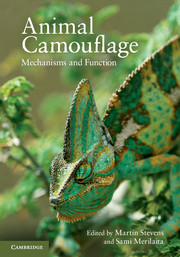Book contents
- Frontmatter
- Contents
- Contributors
- 1 Animal camouflage
- 2 Crypsis through background matching
- 3 The concealment of body parts through coincident disruptive coloration
- 4 The history, theory and evidence for a cryptic function of countershading
- 5 Camouflage-breaking mathematical operators and countershading
- 6 Nature's artistry
- 7 Camouflage behaviour and body orientation on backgrounds containing directional patterns
- 8 Camouflage and visual perception
- 9 Rapid adaptive camouflage in cephalopods
- 10 What can camouflage tell us about non-human visual perception? A case study of multiple cue use in cuttlefish (Sepia spp.)
- 11 Camouflage in marine fish
- 12 Camouflage in decorator crabs
- 13 Camouflage in colour-changing animals
- 14 The multiple disguises of spiders
- 15 Effects of animal camouflage on the evolution of live backgrounds
- 16 The functions of black-and-white coloration in mammals
- 17 Evidence for camouflage involving senses other than vision
- Index
- Plate section
- References
5 - Camouflage-breaking mathematical operators and countershading
Published online by Cambridge University Press: 05 June 2012
- Frontmatter
- Contents
- Contributors
- 1 Animal camouflage
- 2 Crypsis through background matching
- 3 The concealment of body parts through coincident disruptive coloration
- 4 The history, theory and evidence for a cryptic function of countershading
- 5 Camouflage-breaking mathematical operators and countershading
- 6 Nature's artistry
- 7 Camouflage behaviour and body orientation on backgrounds containing directional patterns
- 8 Camouflage and visual perception
- 9 Rapid adaptive camouflage in cephalopods
- 10 What can camouflage tell us about non-human visual perception? A case study of multiple cue use in cuttlefish (Sepia spp.)
- 11 Camouflage in marine fish
- 12 Camouflage in decorator crabs
- 13 Camouflage in colour-changing animals
- 14 The multiple disguises of spiders
- 15 Effects of animal camouflage on the evolution of live backgrounds
- 16 The functions of black-and-white coloration in mammals
- 17 Evidence for camouflage involving senses other than vision
- Index
- Plate section
- References
Summary
Visual camouflage is used by animals as well as humans in order to conceal or obscure their visual signature. In the field of computer vision, work related to camouflage can be roughly divided into two: camouflage assessment and design (e.g. Copeland & Trivedi 1997; Gretzmacher et al. 1998), and camouflage breaking. Despite the ongoing research, only little has been said in the computer vision literature on visual camouflage breaking (Marouani et al. 1995; Guilan & Shunqing 1997; McKee et al. 1997; Ternovskiy & Jannson 1997; Huimin et al. 1999).
- Type
- Chapter
- Information
- Animal CamouflageMechanisms and Function, pp. 73 - 86Publisher: Cambridge University PressPrint publication year: 2011



